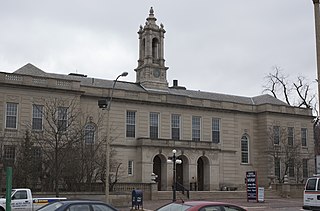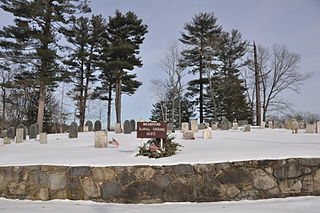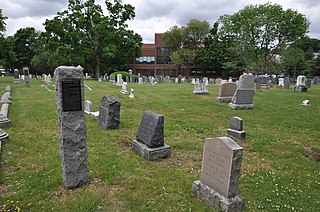
Watertown is a city in Middlesex County, Massachusetts, and is part of Greater Boston. The population was 35,329 in the 2020 census. Its neighborhoods include Bemis, Coolidge Square, East Watertown, Watertown Square, and the West End.

Mount Auburn Cemetery is the first rural, or garden, cemetery in the United States, located on the line between Cambridge and Watertown in Middlesex County, Massachusetts, 4 miles (6.4 km) west of Boston. It is the burial site of many prominent Boston Brahmins, as well as being a National Historic Landmark.

The Edmund Fowle House is a historic house and local history museum at 28 Marshall Street in Watertown, Massachusetts, USA. Built in 1772, it is the second-oldest surviving house in Watertown, and served as the meeting place for the Massachusetts Provincial Congress in the first year of the American Revolutionary War. Now owned by the local historic society, it was listed on the National Register of Historic Places in 1977.

The Rumney Marsh Burying Ground is a historic cemetery on Butler Street between Elm and Bixby Streets in Revere, Massachusetts. It was added to the National Register of Historic Places in 2004. It was the first burying ground of an area that now encompasses Revere as well as neighboring Chelsea and Winthrop.

The Old Cemetery, also known as the Milk Row Cemetery, is a historic cemetery on Somerville Avenue and School Street in Somerville, Massachusetts. Established in 1804 on land donated by Samuel Tufts, it is the city's oldest cemetery. The cemetery was established when Somerville was still a part of Charlestown, and many Somerville residents used that city's Phipps Street Burying Ground, and later the Mount Auburn Cemetery in Cambridge instead of this one. As a result, this cemetery remained small, and was the only one established within the city limits in the 19th century.

High Street Cemetery is a historic cemetery at 45 High Street in Danvers, Massachusetts. The 0.6-acre (0.24 ha) cemetery is one of the older cemeteries in town, and occupies a prominent location in the town center.

The Mechanic Street Cemetery is a historic early cemetery on Mechanic Street in Westfield, Massachusetts. The 4-acre (1.6 ha) cemetery is the city's oldest, with the oldest documented grave dating to 1683. It was used as a burying ground until the late 19th century, although its use began to decline in the middle of the century, with the advent of the popular rural cemetery movement, which was reflected in Westfield with the establishment of the new Pine Hill Cemetery in 1842. No burials were recorded in the 20th century. Although the cemetery has been subjected to some maintenance work, it continues to suffer the effects of vandalism and weather. The cemetery was listed on the National Register of Historic Places in 2002.

Hubbardston Town Common Historic District encompasses the town common of Hubbardston, Massachusetts, the adjacent 1773 First Parish Church, and the town's first burying ground. It has been the center of the town's civic and religious life since its incorporation in the 1760s, and was listed on the National Register of Historic Places in 2000. The district was named as one of the 1,000 Places to Visit in Massachusetts by the Great Places in Massachusetts Commission.

North Cemetery is a historic cemetery in Worthington, Massachusetts. The 3.5-acre (1.4 ha) municipal cemetery is located at the corner of Cold and North Streets not far from Worthington Corners; it is the town's largest cemetery. The cemetery was listed on the National Register of Historic Places in 2004, for its funerary architecture and its role as the burial ground for the town's early settlers.

Hillside Cemetery is a historic cemetery on West Main Street between Brown Street and Charles Street in North Adams, Massachusetts, United States. Located on the western fringe of the city, the earliest portions of the cemetery date to 1798; it is the community's oldest public burying ground. The cemetery is divided by Route 2, with the older section to the north and the younger section to the south. The cemetery's location at the foot of Mount Greylock gives it excellent views of the surrounding area, and of the urban core of North Adams.

Glenwood Cemetery is a historic rural cemetery northeast of Parker Street and Great Road in Maynard, Massachusetts. It is one of the first municipal creations of the town after its incorporation in 1871, and is the resting place of many of its early and prominent residents, including Amory Maynard, founder of the Assabet Woolen Mill and namesake of the community. The cemetery was added to the National Register of Historic Places (NR#04000425) on May 12, 2004.

The Upper Historic District is a historic district encompassing the historic center of Washington, Massachusetts. Centered on the junction of Washington Mountain Road and Branch Road, the town center flourished from the town's establishment in the 1750s until the center of the town's business moved closer to the newly lain railroad in the 1830s. The district includes the old town hall, cemetery, common, and pound, as well as a number of residences. A meeting house (church) and schoolhouse once stood in the area, but the 1792 church was destroyed by lightning in 1859, and the schoolhouse is no longer extant. The district was added to the National Register of Historic Places in 1987.

The Arlington Center Historic District includes the civic and commercial heart of Arlington, Massachusetts. It runs along the town's main commercial district, Massachusetts Avenue, from Jason Street to Franklin Street, and includes adjacent 19th- and early 20th-century residential areas roughly bounded by Jason Street, Pleasant Street, and Gray Street. The district was listed on the National Register of Historic Places in 1974.

The Coolidge School is a historic former school building at 319 Arlington Street in Watertown, Massachusetts. It is a large two story Classical Revival brick building with pressed stone trim, on a granite foundation. It was designed in its present configuration by local architects Clarence Hoyt and Curtis Bixby, and built in two phases. The first phase, built in 1915, was a U-shape structure that is the western portion of the building. In 1925, the eastern wing was added, giving the building its present E shape. The building replaced a previous four-room wood-frame schoolhouse located on School Lane near Mount Auburn Street. The new building, with ten rooms and capacity for over 400 students, was used as an elementary school until 1984. It was afterward used for a variety of purposes, including office space and some educational use, until it was formally closed in 2000.

The Bradford Burial Ground is an historic cemetery at 326 Salem Street in the Bradford section of Haverhill, Massachusetts. The 1.5-acre (0.61 ha) cemetery was established in 1665, on land given by John Heseltine to the town of Bradford. The oldest readable marker in the cemetery has a date of 1689, but there are likely to be older burials. The cemetery was listed on the National Register of Historic Places in 2015.

The North Acton Cemetery, also known locally as the Forest Cemetery, is a historic cemetery Carlisle Road and North Street in North Acton, Massachusetts. Established no later than 1737, it is one of the town's oldest burial grounds, and remained in active use into the 20th century. It has more than 100 marked graves. The cemetery was listed on the National Register of Historic Places in 2019.

The Middle Cemetery is an historic cemetery on Main Street in southern Lancaster, Massachusetts. Established in 1798, it is the town's third oldest cemetery, with active burials taking place until 1969. The cemetery was listed on the National Register of Historic Places in 2019.

The Old Settlers' Burying Ground is an historic cemetery off Main Street in southern Lancaster, Massachusetts. Established by 1674, it is the town's oldest formal cemetery, its burials including family members of many early settlers. The cemetery was listed on the National Register of Historic Places in 2019.
North Cemetery is a historic cemetery at 114 Montague Street in Leverett, Massachusetts, United States. The 1-acre (0.40 ha) municipal cemetery is located on the west side of the street about 1 mile (1.6 km) north of Leverett center. The cemetery, whose oldest documented burials date to 1776, was listed on the National Register of Historic Places in 2020. Its burials include some of the town's early residents.

The Common Street Cemetery is the second oldest documented cemetery in Watertown, Massachusetts. Located at the junction of Common and Mount Auburn Streets in central Watertown, it was founded in 1754. It is the site of Watertown's second meeting house, where major planning and resistance activities took place in the early days of the American Revolutionary War. The cemetery was listed on the National Register of Historic Places in 2022.






















